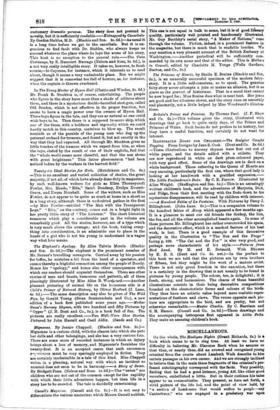—These illustrations to nursery rhymes were first cut out of
white paper, and the details added with a stiletto. They are now reproduced in white on dark plum coloured paper,
with very good effect. Some of the drawings are in dark on a
white background. Those referring to the Queen of Hearts are very amusing, particularly the first one, where that good lady is
looking at her handiwork with a. gratified expression.— The Little Panjandrum's Dodo. By C. E. Farrow. Illustrated by Allan Wright. (Skeffington and Son. 5s.)—This is an amusingly
written children's book, and the adventures of Marjorie, Dick, and Fidge, from their first meeting with the Dodo down to his mysterious disappearance, will be read by children with interest.
—A Hundred Fables of La Fontaine. With Pictures by Percy J.
Billinghurst. (John Lane. 6s.)—This is a companion volume to the hundred fables of sEsop which appeared a few months ago.
It is a pleasure to meet our old friends the donkey, the lion,
the fox, and all the other accomplished beasts again. In some of these pictures Mr. Billinghurst has rather overcrowded his space, and the decorative effect, which is a marked feature of his beet work, is lost. There is a good example of this decorative quality in the illustration to "The Sun and the Frogs"
facing p. 100. "The Cat and the Fox" is also very good, and
perhaps more characteristic of his style.—Pictures from Bird Land. By N. and E. Detmold. With Rhymes
by E. B. S. (Dent and Co. 5s. net.)—In the preface to this book we are told that the pictures are by twin brothers of fifteen, but they might be the work of a mature artist.
There is not only great freedom in the execution, but there is a certainty in the drawing that is not usually to be found in pictures by young people. The colour, too, is delightful ; it is fresh, strong, and harmonious. The charm of these beautiful illustrations consists in their being decorative compositions founded on the characteristic forms and colours of the birds. They thus have an artistic value beyond mere realistic repre-
sentations of feathers and claws. The verses opposite each pie. tare are appropriate to the bird, and are pretty, but not otherwise remarkable.—Master Charlie. By C. Harrison and S. H. Hamer. (Cassell and Co. is. 6d.)—These drawings and the accompanying letterpress first appeared in Little Folks. They make an amusing children's book.






















































 Previous page
Previous page